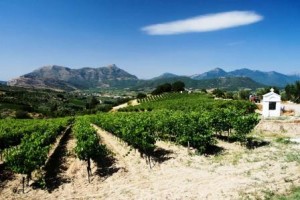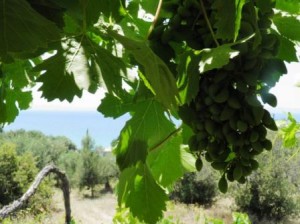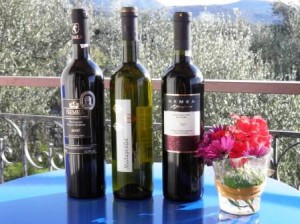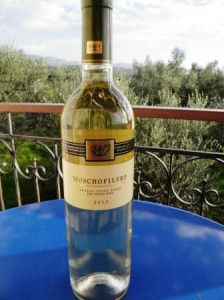Jim’s writing the blog this month, marvelling at Greek wine …
I’VE just sipped a glass of the Blood of Hercules – and it was superb. Don’t worry, I haven’t joined the Kalamata branch of Vampires Anonymous in Greece, I’m simply enjoying a robust red wine from the Peloponnese.
I’m not a wine buff, but I do know that Merlot isn’t a magician, and I’m amazed at the high quality of Greek wine, especially Peloponnesian varieties – from cheap barrelled wine served in tavernas to award-winning bottles produced on wine estates.
Greek wine has come a long way since I first visited the country in the 1970s. In those days it was all jugs of retsina, with enough resin in it to varnish a 12-seater dining table, and bottles of cheap plonk called Domesticos – or more appropriately known as Domestos by British tourists who compared it to the germ-killing household bleach.
Today, there’s a wide choice of wine produced from more than 300 indigenous grape varieties across Greece. Over the past decade, on holiday trips to several islands, I’ve tasted some excellent wines, such as Santorini’s nykteri variety of white wine and Kefalonia’s Robola, another fine white wine sold in bottles with a distinctive hessian covering.
However, I believe the wines of the Peloponnese are the cream of the crop – and excellent value for money. At grassroots level, some of the loveliest wine I’ve tasted has been produced by village taverna owners and their families and sold for as little as three or four euros a litre.
A lot of mass-produced wine in the Peloponnese is sold in 1.5-litre plastic bottles, and much of it is “extremely quaffable” as one British expat and wine expert likes to tell everybody.
A summer favourite is chilled rose wine – a type I’d never touch with a barge pole in the UK and typified by the sweet Mateus Rose from Portugal. The Peloponnese rose is more red than rose coloured and far less sweet than the Portuguese stuff.
Some of the finest rose wine comes from the Monemvasia area of Laconia. Unlike the rest of Greece, most wines consumed in this region of the Peloponnese is rose, with red and white a long way behind. The Laconian vineyards are planted with varieties of grape intermixed in the correct ratio of white and red to achieve the bright colour and bouquet of rose.
In Kalamata, there are two large-scale wineries producing some terrific wines – Inomessiniaki and Bio Vin, which are both near Kalamata Airport – visit their websites www.inomessiniaki.gr and www.biovin.gr Bio Vin wines are made by Ioannis Tsavolakis and come from strictly selected grapes, products of organic viticulture.
The best-known wine-producing area of the Peloponnese is Nemea, south-west of Corinth, turning out dry red wine cultivated from the local agioritiko grapes. One of the finest Greek varieties is called “Blood of Hercules” due to its deep red colour. You can pick up a bottle of decent Nemea red for as little as 3.20 euros in supermarkets in the Peloponnese. Visit the region’s website www.nemeawines.gr
However, try to find these lovely Greek wines in supermarkets in Britain and you’re wasting your time. The only Greek wine I’ve seen on the shelves in Tesco or Morrison is rough-and-ready retsina. As the editor of one wine magazine in Britain told me: “Greek wine is a small, niche market in the UK with little interest”.
Surely Greece, with its economy in meltdown, could seize the chance to boost its beleaguered exports revenue by promoting its superb wines in Britain. It could follow the example of Australian wineries, which came to dominate the British wine market by aggressive marketing – some Aussie wines were on sale in UK supermarkets at lower prices than in Australia. Along with tourism, Greek wines could help get the country back on its feet.
Another great wine-producing region of the Peloponnese is Mantinia, north of Tripoli, which makes lovely white wine from the moschofilero grapes cultivated on the slopes of Mount Mainalo. One of the best moschofilero wines is produced by Ino wines (www.inowines.gr).
A favourite tipple is the malagousia white wine, sold for 3.99 euros at Lidl. This rare Greek variety comes from outside the Peloponnese and is cultivated on the slopes of Mount Kitheron, north of Athens. It easily rivals those tasty sauvignon blancs from New Zealand’s Marlborough region – bursting with a bouquet of exotic fruits …
Good God, now I’m starting to sound like a wine connoisseur. Someone pass me a tin jug of warm retsina and a dirty glass …
You aint nothin’ but a hound dog…
WALLACE our Jack Russell dog has amazed us with his enthusiasm for new hobbies: he’s already mastered high jumping, sprint running, surfing, motorbike riding. Now he’s gone for singing and playing guitar. Great stuff, but why can’t he sharpen up some other abilities as well, like picking the winning numbers for the Euro Millions lottery?
To leave a comment about the blog, please click on our website link http://www.bigfatgreekodyssey.com/Contact-Us.php
© Copyright of the authors 2012





